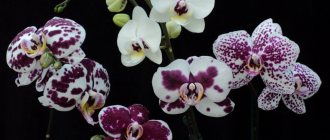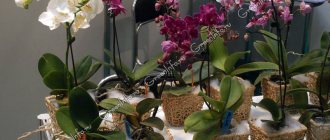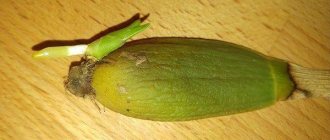Phalaenopsis has taken pride of place on the windowsills of experienced gardeners. And for some, this representative of the Orchid family became the discoverer of a plant collection, winning the heart and soul.
Of the diverse and magnificent varieties, one can note one of the most spectacular exotics - the red orchid. It can become a real decoration in any room or bring joy as a living gift.
In natural conditions, flowers with this color
are rare, but they are not difficult to find among the hybrids on the shelves of flower shops. Caring for plants is simple, but it has its own subtleties and nuances, the implementation of which will allow you to achieve long-term flowering.
Red phalaenopsis orchids
Red flowers are found in different types of orchids. In everyday life, you can most often find phalaenopsis, since compared to other species, they most easily adapt to home conditions.
This genus is represented by more than 70 species of epiphytic plants that are monopodial.
The number of evergreen leaves is approximately 4 to 6, slowly aging, turning yellow and dying. They are then replaced by growing young leaves, reaching a length of up to 50 cm and a width of 5-10 cm.
On window sills, flower growers most often display Phalaenopsis hybrids with a pleasant Ph. amabilis, Phalaenopsis Schiller Ph. schileriana and Phalaenopsis Stewart Ph. stuartia.
Plant collectors, in turn, have a large assortment of species and hybrids.
Advice! The plant is unpretentious. If the conditions are close to natural, then phalaenopsis can delight with its flowering twice a year for 4-5 months. There have been cases when red phalaenopsis delighted with its flowering for as long as 8 months.
Among the orchids with red flowers are the following varieties:
- Vanda is a representative of orchids, not related to phalaenopsis;
- Cattleya is one of the types of orchids with bright flowers (also not phalaenopsis);
- Cymbidium - there are species with red flowers (And this is not phalaenopsis);
- Red Buddha;
- Red Dragon;
- Red Jaguar;
- Harlequin;
- Kimono.
Red Buddha (Buddha's Treasure).
Vanda ampullacea.
Cymbidium Clarisse Austin 'Best Pink'.
Phalaenopsis hybrid Kimono.
Phalaenopsis with red flowers look very luxurious . Up to 40-50 flowers with petals similar to butterfly wings can bloom simultaneously on a flexible stem. This wonderful living plant will become an unusual and bright accent in your home and give it a sweet aroma.
Transplanting a plant
Phalaenopsis is replanted every two years after flowering. However, if the plant's roots have penetrated the drainage holes, it should be replanted immediately. If the orchid becomes crowded, its lower leaves will begin to fall off. The correct transplantation process should be carried out in several stages:
- Purchasing a transparent pot
- Purchasing or making a substrate. Mixing sphagnum moss, tree bark, coal and lowland peat.
- Laying drainage on the bottom of the pot, filling with substrate
- Planting the plant and filling in the missing portion of the soil mixture.
After the above-described manipulations, the orchid is placed in a darkened room for two days with limited watering.
External characteristics and distinctive features
Red phalaenopsis are the most striking representatives of the Orchid family. On window sills you can find several varieties with red flowers:
- Red Buddha belongs to novelty-phalaenopsis. These plants are distinguished by an almost unlimited period of life of peduncles, which grow from the upper vegetative bud after dormant periods. Peduncle few-flowered. But there can be several dozen flower stalks themselves, which ensures lush flowering;
Red Phalaenopsis Buddha's Treasure. - Red Dragon – hybrid of spotted phalaenopsis, belongs to mini varieties;
Phalaenopsis Dragon Tree Eagle 'Red'. - Red Jaguar is a giant phalaenopsis hybrid. This is a large, unusually beautiful plant. It is difficult and capricious to care for, which is why it is not so often found in flower growers’ collections.
Red Jaguar.
Peculiarities
Scarlet orchids at home are better known as phalaenopsis. This exotic plant easily adapts to home conditions. The luxurious plant is monopodial. It has a neat elongated stem, strong leaves, bright green in color. The leaves will retain their brightness and green color for a long time, then turn yellow and die.
The number of inflorescences varies due to maintenance conditions. With proper care, an orchid can produce up to 40 inflorescences in one flowering season.
The flowers have a delicate, pleasant aroma and over time can change shade from bright scarlet to dark red, and the petals themselves resemble butterfly wings.
Let's look at the most popular varieties.
Red peacock
This is the most famous and unique species. The flower is very delicate and thin. Its yellow-red buds are very reminiscent of peacock feathers, which is why the flower got its name.
Red Buddha
It belongs to the novelty phalaenopsis. The flowers are not particularly large in size, but since there can be several dozen of them, they form a lush inflorescence.
Red Dragon
It is a cross between the pinto phalaenopsis. Its inflorescences are small, which gives the flower a special extravagance.
Red Jaguar
This is a monohybrid of the giant phalaenopsis, has large large buds. This amazing, beautiful plant is characterized by capriciousness in care, for this reason it is rarely included in collections.
Regions of distribution in nature
Epiphytic orchids with bright red flowers are widely represented in the plant's homeland in the tropics of South Asia, where there are frequent rainfalls. Such forests are found in Indonesia, the Philippines, New Guinea, the north and east of Australia, and the islands of the Malay Archipelago.
Orchids are considered to be exotic plants that can only grow in the tropics. But in the wild, representatives of the family can be found on almost all continents except Antarctica.
Amazingly, even in the countries of the former Soviet Union you can see 49 representatives of these oldest inhabitants of the flora.
The largest number of varieties of graceful butterfly-like flowers still grow in the humid tropics. It is there that they have the best conditions for development and flowering: suitable air exchange, necessary humidity and protection from the burning sun.
In this area, epiphytic plants that grow upward are found in greater numbers. Temperate climates boast terrestrial varieties of the plant with tuber-shaped rhizomes. There are not very many such plants - about 75.
Orchids are so adaptable to any natural conditions that they are not found only in very cold or dry regions.
Video
The video shows the flowering of one of the red varieties of phalaenopsis, Salus fragrans:
Read about other colors of phalaenopsis: Pink, Yellow, White
The red-burgundy color is not typical for natural species of phalaenopsis. But hybrids of this color are in great demand and are easy to care for. And despite the fact that there are many of them, connoisseurs are constantly looking for rare shades for their collections.
Cattleya - Queen of Orchids
Cattleya is often called the queen among all other orchids. She earned this title not only for her beauty, but also for her “capriciousness” and demanding care. The reward for a painstaking gardener will be beautiful flowers and a sweet aroma.
The homeland of the plant is Brazil. At the moment, about 40 Cattleya hybrids are known, and in natural conditions - about 65.
Cattleya is one of the sympodial species of the Orchid family. Such plants grow in width, as young shoots appear next to old ones. The stem grows from pseudobulbs that appeared earlier and accumulate moisture and vitamins.
Among Cattleyas there are epiphytes that grow on trees, and lithophytes that grow in gorges and rock breaks in open areas under direct sun.
Photo of red Cattleya orchid.
Important! You can distinguish the capricious queen from other species of the Orchid family by the shape of the lip - a petal that contrasts with the color of others in the flower.
The color of the flowers is represented by all known shades. Among the most famous varieties of cattleyas:
- Triana;
- two-color;
- Bowring;
- Forbesa;
- Giant.
On the peduncle of the plant there can be approximately 10 flowers with a diameter of 5 to 25 cm. There are also single inflorescences. Flowering duration is about a month. In autumn and winter, the plant rests.
The height of an adult plant can be about a meter or even higher, starting from just a few centimeters.
Variety selection
Beginning lovers of exotic plants often wonder: are there red orchids? The fact is that unscrupulous sellers often simply paint the flowers of the plant before selling it. You can find out that the shade is artificial only after 6-12 months! You can protect yourself from such purchases. It is enough to get acquainted with the varieties of red orchids. You can't go wrong with the following varieties:
- Ren. James-Story;
- Ren. Philippinensis;
- Howeara Lava burst;
- Blc. Chia Lin New City;
- Ascda Bicentennial.
Care
Of all the types of orchids, phalaenopsis are the most suitable for growing at home. This is a non-capricious variety that, compared to others, requires compliance with minimal conditions.
For successful flowering and growth, phalaenopsis needs:
- Correct lighting;
- Maintaining temperature conditions and maintaining high humidity levels;
- Watering and fertilizing;
- Timely transplant.
Phalaenopsis are light-loving plants that must be protected from direct sun. The most suitable place would be by the east window or on the windowsill.
Phalaenopsis are light-loving plants.
Red phalaenopsis prefers high air humidity and a daytime temperature of approximately 22-27 degrees plus, at night - no lower than +18 degrees Celsius. If you want to achieve flowering, the difference between night and day temperatures should be at least 5 degrees.
Proper watering is one of the main components in plant care. If you make mistakes, the plant may die. During the absence of flowers, phalaenopsis is watered no more than once every 7-10 days. In hot weather, watering is required more often: approximately every 2-4 days.
You can determine the need for watering by looking at the top layer of bark; when it dries out, it needs to be watered. When watering and spraying the plant, it is important not to allow water to get into the axils of the rosettes of the leaves , as this can cause rotting. If moisture gets in, it can be removed with a cotton swab. You cannot water the plant with cold water.
Feeding phalaenopsis is necessary during the period of active growth. Fertilizing is carried out with a solution of complex mineral fertilizers specifically for orchids approximately once every 20-25 days. There is no need to feed the plant during rest.
The growth period of phalaenopsis does not always coincide with the spring-summer period. Flowering can also occur in winter. The resting period of the plant is not as pronounced as, for example, Cattleya.
The dormant period begins at the end of flowering and is determined by the general condition of the plant. At this time, the preferred temperature is 16 degrees Celsius.
be replanted approximately once every 2 years after flowering. But if the plant grows quickly, you can carry out the procedure more often.
Advice! After a dormant period, the plant needs a difference in day and night temperatures for 2-4 weeks to stimulate flowering. Once the buds appear, there should be no temperature changes, otherwise they may fall off.
The peduncle remaining after flowering may remain green and subsequently buds will appear on it again. It can also produce babies for plant propagation. If the peduncle dries out, it should be cut off at a distance of 1-2 cm from the beginning of growth. Sometimes only the top bud on the peduncle may turn yellow or dry out: it should be cut off.
When buying a plant in a flower shop, you need to carefully examine it:
- evaluate the appearance of the plant;
- condition of the rosette - there should be no rotting of the leaves at the base, otherwise the plant will die;
- there should be more unopened buds on the peduncles;
- Evaluate the condition of the roots if possible.
After purchase, the plant may need replanting:
- if the phalaenopsis cannot stand on its own and turns over,
- there is little substrate in the flowerpot and the flower dangles,
- more than half of the roots are damaged.
Transplantation scheme.
If the plant feels good, then it is not advisable to touch it before flowering.
To prevent the occurrence of diseases and pests, the above care requirements should be observed.
Fertilizers
The first application of nutrients is necessary for the orchid immediately after flowering in the store. You should not fertilize just a purchased plant - it gets used to a new place, and therefore experiences serious stress. In this case, fertilizing can be harmful. It is worth remembering the main rule: it is better to underfeed an orchid than to overfeed it! It is not recommended to use fertilizers in the form of tablets - they will not be able to be evenly distributed in the substrate. The only way to fertilize is an aqueous solution.
Flower growers recommend combining fertilizer with watering the plant. During every second watering it is worth adding nutrients. By the way, it is better to choose a special fertilizer for orchids. If you cannot find one, you can feed the tropical flower with universal fertilizer for indoor plants. But it is necessary to pay attention to the nitrogen content - a large amount of it can adversely affect the flowering of red orchids. Therefore, the dose of complex fertilizer should be reduced: the best option is 1/3 of that indicated on the label.
Separately, it is worth mentioning that fertilizer cannot heal a sick orchid. A weakened or diseased flower must be cured and only then fertilized.
Photo
Below are photos of different varieties of red orchid . Enjoy them.
"Ascocenda"
"Phalaenopsis"
"Wanda"
"Cymbidium"
"Cattleya"











